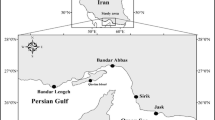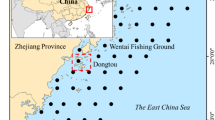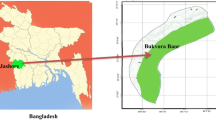Abstract
The length-weight relationship, patterns of growth, mortality and exploitation are fundamental and useful information for fishery management. Investigations were carried out to study the length-weight relationship, growth, mortality and exploitation of Harpadon nehereus in the Min River Estuary, East China Sea, in 2015. A total of 938 specimens ranging from standard lengths of 5.9 to 25.0 cm was subjected for analysis. The length-weight relationship of H. nehereus in the Min River Estuary was W = 0.0007 L3.81 (R2 = 0.96). The high value of b was verified to be influenced by the reproduction and feeding behaviours, which were different from those of H. nehereus in the Indian Ocean. The von Bertalanffy growth equation was derived as Lt = 26.9 (1-e −0.94 × (t - (−0.12))). The total, natural and fishing mortality rates were 3.27, 1.58 and 1.69 year−1, respectively. The exploitation level of H. nehereus stock was estimated to close to an appropriate fishing pressure on the stock. We recommend maintaining the fishing intensity and renewing the size of H. nehereus at first capture (Lc = 18.07 cm) in the Min River Estuary.




Similar content being viewed by others
References
Anderson RO, Gutreuter SJ (1996) Length, weight, and associated structural indices. In: Murphy BR, Willis DW (eds) Fisheries techniques, 2nd edn. American Fisheries Society, Bethesda, pp 447–481
Beverton RJH, Holt SJ (1959) A review of the lifespans and mortality rates of fish in nature, and their relation to growth and other physiological characteristics. In: GEW W, O'Conner M (eds) Ciba Foundation Colloquia on Ageing - The Lifespan of Animals. John Wiley & Sons, Chichester, pp 142–180
Beverton RJH, Holt SJ (1966) Manual of methods for fish stock assessment. Part II. Tables of yield function. FAO fishery biology technical paper, no. 38, Version 1, FAO, Rome, pp 67
Biradar RS (1989) Stock assessment of Bombay duck (Harpadon nehereus) off Maharashtra, India. In: Venema SC, Van Zalinge NP (eds) Contributions to tropical fish stock assessment in India, FAO, Rome, pp 31–44
Carlander KD (1969) Handbook of freshwater fishery biology, Vol. 1. The Iowa State University Press, Ames
Carlander KD (1977) Handbook of freshwater fishery biology, Vol. 2. The Iowa State University Press, Ames
Chen Z, Wu S, Xia D, Xie Q, Chen F, Hu H, Zhang J, He B (1998) Chinese bays (the fourteenth series): important estuaries. China Ocean Press, Beijing
Costanza R, D'Arge R, Groot RD, Farber S, Grasso M, Hannon B, Limburg K, Naeem S, O'Neill RV, Paruelo J (1997) The value of the world's ecosystem services and natural capital. Nature 387:253–260
Day JW, Hall CAS, Kem PWM, Yáñez-Arancibia A (1989) Estuarine Ecology. John Wiley & Sons, New York, Chichester, Brisbane, Toronto, SingaPore
Elliott M, Mclusky DS (2002) The need for definitions in understanding estuaries. Estuar Coast Shelf Sci 55(6):815–827
Froese R (2006) Cube law, condition factor and weight–length relationships: history, meta-analysis and recommendations. J Appl Ichthyol 22(4):241–253
Froese R, Pauly D (eds) (2017). FishBase. [Available at http://www.fishbase.org, accessed May 2018]
Fulton TW (1904) The rate of growth of fishes. Twenty-second annual report, Part III. Fisheries Board of Scotland, Edinburgh, pp 141–241
Gayanilo FC, Sparre P, Pauly P (2005) FiSATII: FAO-ICLARM stock assessment tools II, user’s manual. FAO, Rome, pp 168
Ghosh S, Pillai NGK, Dhokia HK (2009) Fishery and population dynamics of Harpadon nehereus (ham.) off the Saurashtra coast. Indian J Fish 56(1):13–19
Gulland JA (1969) Manual of methods for fish assessment - part 1, fish population analysis. FAO. http://www.fao.org/docrep/x5685e/x5685e00.htm. Accessed 5 June 2018
Hansen EA, Closs GP (2009) Long-term growth and movement in relation to food supply and social status in a stream fish. Behav Ecol 20(3):616–623
Heincke F (1908) Bericht über die Untersuchungen der Biologischen Anstalt auf Helgoland zur Naturgeschichte der Nutzfische. (1. April 1905 bis 1. Oktober 1907). In: Die Beteiligung Deutschlands an der Internationalen Meeresforschung, 4. & 5. Jahresbericht, Verlag von Otto Salle, Berlin, pp 67–150
Huang LM (2011) Study on fishery resources and fish diversity in Minjiang River estuary and Jiulong River estuary and their adjacent waters. Dissertation. Ocean University of China
Huang LM, Li J, Zhang YZ, Xie YJ (2010) Current fishery resource assessment in the Minjiang River estuary and its neighboring waters. J Trop Oceanogr 29(5):142–148
Isaac VJ (1990) The accuracy of some length-based methods for fish population studies. International Center for Living Aquatic Resources Management, Philippines
Jellyman DJ (1997) Variability in growth rates of freshwater eels (Anguilla spp.) in New Zealand. Ecol Freshw Fish 6(2):108–115
Jellyman PG, Booker DJ, Crow SK, Bonnett ML, Jellyman DJ (2013) Does one size fit all? An evaluation of length–weight relationships for New Zealand's freshwater fish species. N Z J Mar Freshw Res 47(4):450–468
Khan MZ (1989) Population dynamics of the Bombay duck, Harpadon nehereus (ham.) off Saurashtra coast. Indian J Fish 36(2):93–101
Le Cren ED (1951) The length–weight relationship and seasonal cycle in gonad weight and condition in the perch (Perca fluviatilis). J Anim Ecol 20(2):201–219
Liang C, Pauly D (2017) Growth and mortality of exploited fishes in China’s coastal seas and their uses for yield-per-recruit analyses. J Appl Ichthyol 00:1–11
Lin LS (2009) Spatial distribution and environmental characteristics of Harpadon nehereus in the East China Sea region. J Shanghai Ocean Univ 18(1):66–71
Lin LS, Zheng YJ, Cheng JJ, Liu Y (2006) A preliminary study on fishery biology of main commercial fishes surveyed from the bottom trawl fisheries in the East China Sea. Mar Sci 30(2):21–25
Luo HZ, Zhang HD, Li PF, Zhou RD (2012) Analysis of the current situation of fishery biology of Harpadon nehereus in the East China Sea. J Zhejiang Ocean Univ (Nat Sci) 31(3):202–205
Nurul Amin SM (2001) Studies on age and growth, VPA analysis and relative condition factor of Harpadon nehereus (ham-Buch) from the neritic water of Bangladesh. J Biol Sci 1(4):192–194
Olaso I, Rauschert M, Broyer CD (2000) Trophic ecology of the family Artedidraconidae (Pisces: Osteichthyes) and its impact on the eastern Weddell Sea benthic system. Mar Ecol Prog Ser 194:143–158
Pan XW (2011) The primary study on biology of Harpadon nehereus in the east. Dissertation. Shanghai Ocean University
Panda D, Jaiswar AK, Sarkar SD, Chakraborty SK (2016) Growth, mortality and exploitation of bigeye scad, Selar crumenophthalmus off Mumbai, north-west coast of India. J Mar Biol Assoc UK 96(7):1411–1416
Pauly D (1979) Theory and management of tropical multispecies stocks; a review, with emphasis on the Southeast Asian demersal fisheries. International Center for Living Aquatic Resources Management, Philippines
Pauly D (1980) On the interrelationships between natural mortality, growth parameters, and mean environmental temperature in 175 fish stocks. ICES J Mar Sci 39(2):175–192
Ricker WE (1975) Computation and interpretation of biological statistics of fish population. Bull Fish Res Board Can 191:382
Safran P (1992) Theoretical analysis of the weight-length relationship in fish juveniles. Mar Biol 112(4):545–551
Sparre PJ, Venema SC (1992) Introduction to tropical fish stock assessment- part I: manual. Fisheries tech. Rep. No. 306/ rev.1. FAO, Rome, p 376
Sparre PJ, Venema SC (1998) Introduction to tropical fish stock assessment- part I: manual. Fisheries tech. Rep. No. 306/ rev. 2. FAO, Rome, p 407
Sun RL, Chen ZH (1986) The gillnet fishery for Harpadon nehereus in Zhejiang. Marine Fisheries (5):215–216
Tesch FW (1968) Age and growth. In: Ricker WE (ed) Methods for assessment of fish production in fresh waters. Blackwell Scientific Publications, Oxford, pp 93–123
Tesch FW (1971) Age and growth. In: Ricker WE (ed) Methods for assessment of fish production in fresh waters, 2 nd. Blackwell Scientific Publications, Oxford, pp 97–130
Wang JQ, Zhang YZ, Huang LM (2011a) Fishery biology of main economic fishes in Fujian coastal waters. J Jimei Univ (Nat Sci) 16(3):161–166
Wang Y, Wang YB, Zheng J (2011b) A preliminary study on biology of main commercial fishes surveyed from the single otter trawl fisheries in Zhoushan fishing ground outside the forbidden fishing line. J Zhejiang Ocean Univ (Nat Sci) 5(5):416–419
Wang JQ, Huang LM, Li J, Zhang YZ, Zhu GP, Chen XJ (2016) Length-weight relationships of 45 fish species in the Min River estuary, East China Sea. J Appl Ichthyol 32(1):131–133
Xu ZL (2010a) Comparison of fish density between the Minjiang estuary and Xinghua Bay during spring and summer. J Fish China 33(22):7157–7165
Xu ZL (2010b) Comparison of distribution of pelagic fish egg and larva between the Minjiang estuary and Xinghua bay. J Shanghai Ocean Univ 19(6):822–827
Yue DD, Wang LM, Zhang X, Zheng HF, Zhang HY (2015) Status and reflections of the summer closed fishing in the East China Sea. J Agric Sci Technol 17(4):122–128
Zhan BY (1995) Fisheries stock assessment. China Agriculture Press, Beijing
Zhang QY (1985) Scopeliformes: Synodidae. In: Chu YT (ed) The fishes of Fujian province (PartI). Fujian Science and Technology Press, Fuzhou, pp 174–175
Author information
Authors and Affiliations
Corresponding author
Additional information
Publisher’s Note
Springer Nature remains neutral with regard to jurisdictional claims in published maps and institutional affiliations.
Rights and permissions
About this article
Cite this article
He, X., Li, J., Shen, C. et al. Length-Weight Relationship and Population Dynamics of Bombay Duck (Harpadon nehereus) in the Min River Estuary, East China Sea. Thalassas 35, 253–261 (2019). https://doi.org/10.1007/s41208-018-0117-7
Published:
Issue Date:
DOI: https://doi.org/10.1007/s41208-018-0117-7




